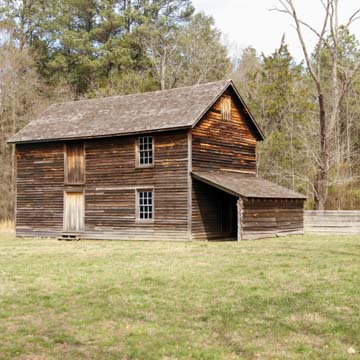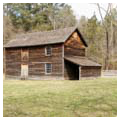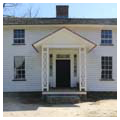Duke Homestead was the home of tobacco industry pioneer Washington Duke and the birthplace of his son, tobacco magnate and philanthropist James Buchanan Duke. Preserved because of its association with this important North Carolina family, it also represents the innumerable middling farmsteads that were once found across the state. The approximately 40-acre site includes Duke’s 1852 farmhouse, a reconstructed 12 x 14–foot log barn, the 1869 two-story factory building (known as the third factory), a relocated pack house, and a domestic smokehouse and well house. Washington Duke built the substantial farmhouse in anticipation of his second marriage to Artelia Roney of Alamance County in 1852. He already had two sons, Sidney Taylor and Brodie Leonidas, with his first wife, Mary, who died in 1847. Washington and Artelia’s family expanded with the arrival of Mary, Benjamin, and James Buchanan (“Buck”).
The two-story frame structure rests on a stone foundation and is wrapped in clapboard siding and covered by a cedar-shingled gable roof. The symmetrical facade features a gabled entry porch with delicate wooden supports (reconstructed in the 1930s) and front door with transom and sidelights. Sloped sills are the only trim detail around the windows. The central brick chimney and stair lobby are flanked by two rooms neatly finished in hand-planed heart-of-pine sheathing. The original kitchen was a log structure separate from the house, but sometime in the 1860s a kitchen ell was added to the rear. The kitchen has a whitewashed interior and is separated from the dining room by a stone chimney.
Duke raised diverse crops and in 1850 his farm was worth $381. He reportedly began growing tobacco in 1859 after a failed cotton crop, a year after his second wife died. He was drafted into the Confederate army in 1863 and was captured by Union forces in in 1864. He returned home after the war and enlisted his sons in growing and manufacturing tobacco. Immediately after the war, soldiers who had been stationed near Durham began seeking out supplies of Durham tobacco, and the local industry blossomed. Duke converted an old corncrib into his first tobacco factory. Traveling the region, the Dukes sold their tobacco in packages marked Pro Bono Publico or “for the Public good.” In 1870, Duke erected a barn-like tobacco factory, the first building on the homestead built specifically for tobacco manufacture. Also on the site is a log tobacco curing barn typical of the flue-cured tobacco barns seen throughout the region, in which the leaf was cured through a carefully regulated heating process.
By 1868, Duke began funding his son Brodie’s tobacco factory in Durham. He soon moved to Durham where, in 1880, he built a large Queen Anne house called Fairview (no longer extant) not far from the family’s later immense tobacco factory. W. Duke and Sons soon became a major manufacturer of tobacco. Duke retired in 1880 and left James Buchanan in control. The business expanded to manufacturing cigarettes and eventually came to dominate the industry nationally when it adopted the Bonsack cigarette rolling machine in 1884. In 1890 James brokered a merger of the five largest tobacco companies in the United States and for twenty years controlled the largest tobacco industry in the world until the Supreme Court dissolved the American Tobacco Company in 1911.
Duke was an active philanthropist in retirement and worked to bring Trinity College to Durham in 1890. He refused to have the school renamed after him when he endowed the university with $100,000 in 1896, a request that would be superseded when James Buchanan increased the Duke endowment by $40 million. Seven years later, the newly renamed Duke University acquired the Duke Homestead. Previously it had changed ownership several times since the Duke family sold it in 1874. In the 1930s, Duke University reconstructed the log barn, which had been lost to fire, to approximate the farm building used as Duke’s first factory; the University also restored the extant structures on the property. The university gifted the site to the State of North Carolina in 1973. The State Historic Sites program conducted archaeological excavations and based on its findings, a swept yard and picket fence were reconstructed in the early 1980s.
Since it was acquired by Duke University, the site has been open to the public. Now a museum, the grounds include the historic structures as well as a 5,500-square-foot visitor center that contains exhibits dedicated to the history of tobacco.
References
Bishir, Catherine W., and Michael T. Southern. A Guide to the Historic Architecture of Piedmont North Carolina. Chapel Hill: University of North Carolina Press, 2003.
Fenn, Elizabeth A. “The Quest for Progress.” In The Way We Lived in North Carolina. Chapel Hill: University of North Carolina Press, 2003.
North Carolina Department of Cultural Resources. “North Carolina Historic Sites-Duke Homestead.” NC Historic Sites. Accessed February 12, 2019. http://www.nchistoricsites.org/.
Rettig, Polly, and Horace Sheely, “Duke Homestead and Tobacco Factory,” Durham County, North Carolina. National Register of Historic Places Inventory–Nomination Form, 1975. National Park Service, U.S. Department of the Interior, Washington, D.C.











